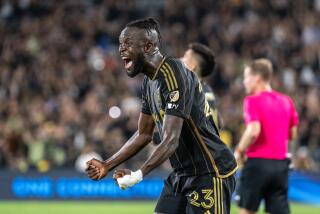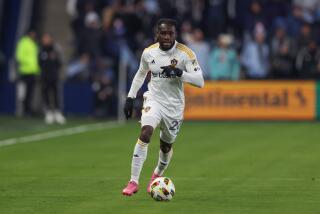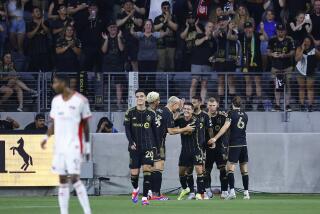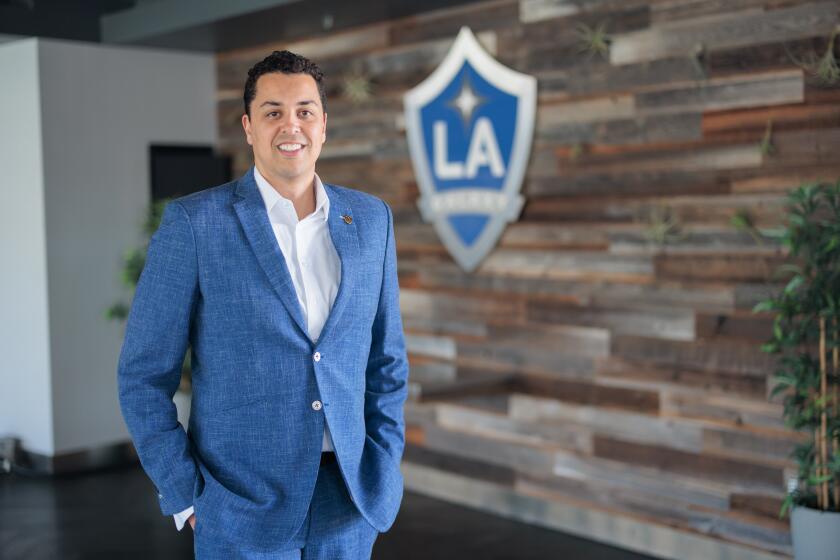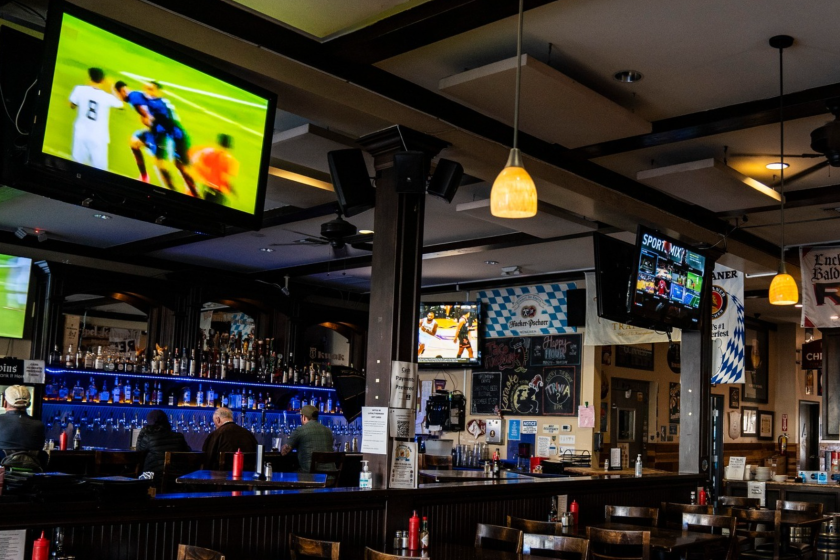Dayakâs Odyssey Reaches Zenith
Itâs the sort of injury that frightens those who see it occur, let alone those who are actually involved.
One playerâs knee meets another playerâs head with such force that the impact compresses the vertebrae in the neck and spine. Paralysis is often the result.
âI was told by doctors that my career was over, that I would never play soccer again,â Troy Dayak said.
That was four years ago.
Today, Dayak will be the most unsung but arguably the most deserving player on the field when Major League Soccer stages its sixth annual All-Star game, at Spartan Stadium in San Jose.
After coming within millimeters of losing everything, Dayak has come all the way back.
Doctors and rehabilitation therapists receive much of the credit, of course. Some goes to Dallas Cowboy Daryl Johnston, who suffered a similar injury and provided moral support. But it was Dayakâs determination that made the difference in the end.
The San Jose Earthquake defender was 26 when the injury occurred. At the time, the potential consequences stunned him as much as the pain, which was almost unbearable.
âIt was shocking,â he said. âItâs one of those things where you say, âWhat am I going to do now?â Right from high school I turned professional to play with the San Francisco Bay Blackhawks. To me it was unbelievable that I was not going to be able to play the sport I love or earn a living for my family or myself.â
It was an accident, pure and simple, that almost cost the former U.S. national team player--a 1991 Pan American Games gold medalist and 1992 Olympian--his soccer career.
The Earthquakes were holding a scrimmage at Spartan Stadium and Dayak was in a race for the ball with an opposing forward.
âI beat him to the ball and the ball was heading into the penalty area, but the goalkeeper was coming out at the same time,â Dayak explained.
âThe forward unintentionally clipped my heels and it was a freak thing. I fell right in front of the keeper, who was coming out to slide tackle the ball away because it was at the edge of the box.
âThe goalkeeperâs knee [struck] the top of my head in [what Dayak learned later was] an axial load impact and compressed [the vertebrae] so strongly that it [a disk just below his neck] ruptured. The doctor told me after looking at the MRI that it was within millimeters of paralyzation.â
The Cowboysâ Johnston suffered a similar injury at roughly the same time.
âWe spent a lot of time on the phone calling each other back and forth getting progress reports,â said Dayak, who had turned down a football scholarship from Oregon State to stick with soccer. âIt was good to have someone to get along with and who knows what youâre feeling. Unfortunately for âMoose,â heâs retired now.â
The severity of the injury was not immediately apparent and was initially diagnosed as nothing more than a pinched nerve.
âIt [the pain] was excruciating,â Dayak said. âI remember after the game I couldnât even drive home. I had to have someone drive me home. I remember sleeping while sitting straight up in the chair because I couldnât lie down flat on my back.â
Astonishingly, Dayak kept playing.
âI played the next six [MLS] games, taking painkillers before and after games, and muscle relaxers at halftime,â he told the San Jose Mercury News earlier this year.
Eventually, an MRI was performed and Dayak was told he had a herniated disk. Medical opinion varied. One doctor said he never would play again. Another said surgery was unnecessary.
Dayak opted for no surgery and rejoined the Earthquakes [then still known as the Clash] for the 1998 MLS season. Almost exactly a year after the initial injury, he again played in an MLS game.
Seven games later, he ruptured the same disk while battling for a header. This time surgery had to be done. Doctors used bone from his hip to fuse the disk in place and it appeared his career was over.
But Dayak wasnât done.
âThe best thing I could have done was to have the surgery,â he said. âFrom then on, it was a matter of strengthening the muscles around the neck and strengthening my body so they [the muscles] can work as shock absorbers.â
The Earthquakes waived him before the 1999 season, so Dayak signed with the Bay Area Seals of the A-League.
In his third game with the Seals, he tore ligaments in his right knee. He underwent surgery, returned to play in a brace, eventually discarded that and stayed with the Seals as player/assistant coach through 2000.
Then, six months ago, he showed up at the Earthquakesâ training camp like a ghost from the past.
âTo be honest, I donât think at first we really understood what had happened to him,â San Jose goalkeeper Joe Cannon said. âHe came to us one day and it was kind of like, âHey, Troy Dayakâs coming out with us.â
âI was like, âTroy Dayak? That guyâs like 35 or 36 years old. He used to play for the Blackhawks when I was a kid. I think I remember him.â â
But the story of Dayakâs ordeal soon made the rounds.
âWe started to read about the seriousness of what he went through,â said Cannon, who is also an all-star today. âThe guy was literally sitting in a chair staring up at the ceiling for months on end, getting very frustrated with his daily life because he couldnât play the game he loved.â
On April 7, in the MLS season opener against the Galaxy at the Rose Bowl, 30-year-old Troy Dayak not only started for San Jose but scored its first goal in a 3-2 victory.
âI felt like I jumped out of my skin completely.â he said of the moment. âI lost my voice and winded myself in the celebration after the goal. I literally gave myself stomach cramps. I could barely play for the next 10 minutes.
âIt meant so much to me. I wanted it more than any of the 22 players out there. It shows you that when you work hard at things and you strive for something, good things happen.
âBut the chapter is not closed yet. I still have a lot of soccer to play.â
(BEGIN TEXT OF INFOBOX / INFOGRAPHIC)
MLS All-Star Game
Site--Spartan Stadium, San Jose. Time--12:30 p.m. TV--Channel 7
ROSTERS
West--Goalkeepers: Joe Cannon (San Jose), Zach Thornton (Chicago); Defenders: Jeff Agoos (San Jose), Marcelo Balboa (Colorado), Troy Dayak (San Jose), C.J. Brown (Chicago), Diego Gutierrez (Chicago); Midfielders: Landon Donovan (San Jose), Chris Armas (Chicago), Chad Deering (Dallas), DaMarcus Beasley (Chicago), Mauricio Cienfuegos (Galaxy), Matt McKeon (Kansas City), Dema Kovalenko (Chicago), Cobi Jones (Galaxy), Manny Lagos (San Jose), Jesse Marsch (Chicago); Forwards: Ariel Graziani (Dallas), Jason Kreis (Dallas), Luis Hernandez (Galaxy), John Spencer (Colorado), Ronald Cerritos (San Jose). Coach--Bob Bradley (Chicago).
East--Goalkeepers: Nick Rimando (Miami), Tim Howard (NY/NJ); Defenders: Eddie Pope (D.C. United), Carlos Llamosa (Miami), Mike Petke (NY/NJ), Mike Clark (Columbus), Steve Jolley (NY/NJ), Pablo Mastroeni (Miami); Midfielders: Clint Mathis (NY/NJ), Ben Olsen (D.C. United), Preki (Miami), Bobby Convey (D.C. United), Jim Rooney (Miami), Marco Etcheverry (D.C. United), Ian Bishop (Miami), John Wilmar Perez (Columbus), Cate (New England); Santino Quaranta (D.C. United); Forwards: Brian McBride (Columbus), Alex Pineda Chacon (Miami), Diego Serna (Miami), Mamadou Diallo (Tampa Bay). Coach--Ray Hudson (Miami).
PREVIOUS RESULTS
*--*
Year Result Site 1996 East 3, West 2 Giants Stadium, East Rutherford, N.J. 1997 East 5, West 4 Giants Stadium, East Rutherford, N.J. 1998 American 6, World 1 Citrus Bowl, Orlando, Fla. 1999 West 6, East 4 Qualcomm Stadium, San Diego 2000 West 9, East 4 Crew Stadium, Columbus, Ohio
*--*
